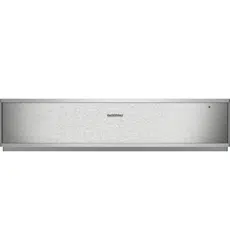Loading ...
Loading ...
Loading ...

14
Uses
The table shows various uses for the warming drawer. Set the function selector to the desired setting. Preheat the
ovenware as indicated in the table.
Slow cooking
Slow cooking is the ideal cooking method for all tender
pieces of meat which are to be cooked rare or very rare.
The meat remains very juicy and turns out as soft as
butter. Advantage: this gives you flexibility when
planning meals, since the cooking times for slow
cooking are generally longer. Slow-cooked meat can be
kept warm easily.
Suitable ovenware: Use ovenware made out of glass,
porcelain or ceramic and with a lid, e.g. a glass roasting
dish.
Method
1 Preheat the warming drawer containing the
ovenware at setting 4.
2 Rapidly heat a little fat in a pan. Sear the meat over
a high heat and then place it directly in the warmed
ovenware. Place the lid on top.
3 Put the ovenware with the meat back in the warning
drawer and complete the cooking. Set the function
selector to setting 3.
Notes on slow cooking
Only use high-quality, fresh meat for this. Carefully
remove sinews and fat. Fat develops a strong, distinct
taste during slow cooking.
The meat should not be turned even if it is a large joint.
You can cut the meat immediately after slow cooking. It
is not necessary to leave the meat to stand.
This particular cooking method always leaves the inside
of the meat medium rare. However, this does not mean
that it is raw or not properly cooked.
Meat that has been slow-cooked is not as hot as meat
that has been cooked conventionally. Serve the sauce
very hot. Place the plates in the warming drawer for the
last 20-30 minutes.
Turn the oven back to setting 2 after slow cooking in
order to keep the slow-cooked meat warm. You can keep
small pieces of meat warm for up to 45 minutes, and
large pieces for up to two hours.
Level Food / ovenware Note
1 Delicate deep-frozen food e.g. cream cakes, butter, sau-
sages, cheese
Defrost
1 Leaving yeast dough to rise Cover
2 Deep-frozen food e.g. meat, cakes, bread Defrost
2 Keeping eggs warm e.g. hard-boiled eggs, scrambled eggs Preheat ovenware, cover food
2 Keeping bread warm e.g. toast, bread rolls Preheat ovenware, cover food
2 Preheating drinks containers e.g. espresso cups
2 Delicate food e.g. slow-cooked meat Cover ovenware
3 Keeping food warm Preheat ovenware, cover food
3 Keeping drinks warm Preheat ovenware, cover drinks
3 Warming flat dough-based foods e.g. pancakes, wraps,
tacos
Preheat ovenware, cover food
3 Warming dry cakes e.g. crumble cakes, muffins Preheat ovenware, cover food
3 Melting cooking chocolate or chocolate coating Preheat ovenware, break up food into small pieces
3 Dissolving gelatine Open, approximately 20 minutes
4 Preheating ovenware Not suitable for drinks containers
Loading ...
Loading ...
Loading ...
